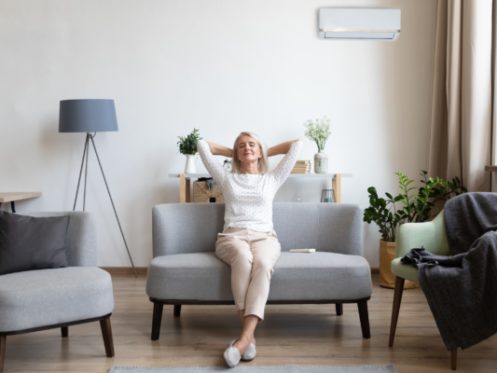When battling the sweltering summer heat, choosing the right AC system for your needs is crucial. But when it comes to air conditioning, you have a huge range of options. Here are some pros and cons of the most popular AC systems available in the St. Louis market to help you make an informed decision.
1. Central Air Conditioning Systems
Central air conditioning systems are a staple in many homes, offering consistent and even cooling throughout the entire living space.
Pros
These systems utilize a network of ducts to distribute cooled air, ensuring a comfortable environment in every room. Central AC systems also have advanced filtration options, improving indoor air quality by trapping dust, allergens, and pollutants. Moreover, they often have programmable thermostats that allow you to control temperature settings and optimize energy usage.
Cons
Conversely, central AC systems can be costly to install, especially in homes that lack existing ductwork. The installation process can also be intrusive, involving modifications to walls and ceilings.
Additionally, these units consume significant energy, resulting in higher utility bills, especially if the ducts are not well insulated. These systems also take longer to cool down a room than newer alternatives, which might be inconvenient on scorching days.
2. Ductless Mini-Split Systems
Ductless mini-split systems consist of an outdoor compressor unit and one or more indoor air handlers connected by a small conduit. Ductless systems are known for their energy efficiency, as they can be turned on or off in specific zones, reducing energy waste.
Pros
One significant advantage of these systems is that they can set different temperatures in different zones. This allows for personalized comfort throughout the home. You won’t be wasting energy cooling rooms that you don’t use.
This type of system is ideal for older houses, additions, or converted attics and basements. Installation is less invasive, as it doesn’t require ductwork.
Cons
While ductless mini-split systems offer many benefits, they might only fit some situations. The initial upfront cost can be higher than for traditional systems. While the installation is less invasive, it still requires drilling holes for the conduit, which might add to the cost and only suit some. Additionally, the indoor air handlers can be noticeable, affecting the aesthetics of your living space.
3. Window Air Conditioners
A window air conditioner is designed to cool a single room or a small area. It is typically installed in a window or a specially designed opening in a wall.
Pros
Window air conditioners are a budget-friendly and simple solution for cooling specific rooms. They are easy to install and can be a practical choice for renters or those on a tight budget. These compact units don’t require much space, making them popular for small apartments or bedrooms. They’re also relatively easy to maintain, with washable filters that can be cleaned and reused.
Cons
Window AC units are designed to cool a single room, meaning you might need multiple units for a larger home. Furthermore, they can be noisy, disrupting your comfort or sleep. Their installation also requires an adequately sized window, which might not suit some room layouts. Window AC units can also be a security risk. Finally, they are prone to leaking water, damaging your home and belongings.
4. Portable Air Conditioner
A portable air conditioner is a compact, self-contained cooling unit designed to provide localized cooling in a room or specific area. Portable air conditioners typically have wheels for easy mobility.
Pros
Unlike other cooling solutions that require modifications to your home’s structure, portable air conditioners do not require permanent changes. You don’t have to create holes in walls or windows for installation. In addition, setting up a portable air conditioner is straightforward. Most units have a user-friendly control panel, remote control, and adjustable settings for temperature, fan speed, and mode. Because of their portability, they can easily be moved from room to room if you can only afford a single unit.
Cons
While portable AC units provide convenience, they might not be as efficient as other systems, particularly in larger spaces. They also require a window for exhaust venting, which can limit their placement options. Also, portable units have a drain pan for the condensate. You must remember to empty this regularly, or it will overflow.
5. Packaged Air Conditioning System
Packaged air conditioning systems are all-in-one units that combine the compressor, condenser, and air handlers in a single package. This single unit is installed outside the home.
Pros
Packaged air conditioning systems integrate all components (compressors, coils, and fans) into a single unit, simplifying installation and maintenance. These systems suit various spaces, from small offices to large commercial buildings. They provide consistent temperature control, improved air quality through filtration, and reduced noise indoors due to external placement. Packaged systems are cost-effective, with options for customization and energy-efficient models.
Cons
One potential drawback of packaged systems is that they might offer a different energy efficiency level than other options, especially if you’re looking for zoned cooling. Additionally, these units can be complex to repair and maintain since all the components are integrated into a single package. They are also prone to rest, as the entire system is outside.
6. Heat Pump
A heat pump works by moving heat from one area to another. This system can heat and cool a home.
Pros
Because a heat pump can both heat and cool a home, you only need to purchase a single unit. For cooling, it basically works the same as a conventional central air conditioner.
Cons
A heat pump is sufficient year-round in an area with mild winters. However, you may need an additional heater in colder climates to provide enough warmth during the winter. This will significantly increase your upfront costs. Additionally, these systems might require more maintenance and attention since they operate year-round. The complexity of the system can also make repairs more challenging.
7. Geothermal Heat Pump System
Geothermal heat pumps use the earth’s natural heat to heat and cool.
Pros
Geothermal heat pump systems offer a longer lifespan than traditional HVAC systems, with fewer mechanical components exposed to weathering. These systems are environmentally friendly, emitting minimal greenhouse gases and reducing reliance on fossil fuels. They often qualify for tax incentives and rebates, further enhancing their affordability while contributing to sustainable and eco-conscious living.
Cons
Not every home will have the right conditions for a geothermal heat pump. The installation cost of geothermal systems can be substantial, as it involves digging into the ground to install the heat exchange system. Repairs and maintenance can also be more specialized and potentially costly.
Making the Decision
Considering the wide range of AC systems available, selecting one that aligns with your needs and preferences is essential. At Agers Heating & Air Conditioning, we understand the significance of choosing the right AC system for your home in St. Peters and throughout the St. Louis area. Our team of experts is dedicated to assisting you in finding the ideal solution that balances comfort, efficiency, and affordability. We offer various services beyond AC installation, including maintenance and repairs for various heating and cooling systems. We also offer routine maintenance plans and commercial services.
Contact Agers Heating & Air Conditioning today for more information, and let us help you create the perfect indoor environment for every season.




